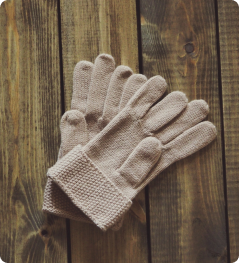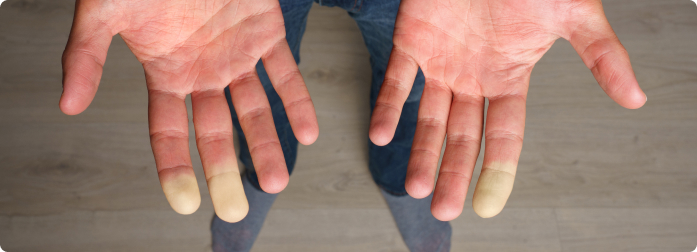People with lupus have higher rates of a condition called Raynaud’s Syndrome. Raynaud’s is caused by vascular constriction in response to exposure to cold temperatures or emotional stress that produces color change in the fingers and toes. The ends of one or several fingers may suddenly turn white, then blue before turning red and returning to normal color. Attacks can cause pain which may feel like pins and needles, numbness, clumsiness or aching which should resolve as blood flow and color returns. In a few patients with autoimmune disease who have Raynaud’s, low blood flow can cause skin ulcerations. Be sure to talk with your doctor if you notice ulcerations.



Tips to Reduce Raynaud’s Symptoms
Back to topIn cold weather, wear layers of warm clothing, a hat, heavy socks and gloves. If possible, avoid exposure to sudden warm to cold temperature changes. Air conditioning may be enough to trigger an attack for some. Others avoid reaching into the freezer section at the grocery store or wear gloves while shopping.
Reduce stress by learning to identify and avoid emotionally stressful situations which may reduce attacks. Take a look at Managing Emotions to learn more.
Exercise regularly to promote healthy blood circulation. See more about movement in the Physical Activity section.
Quit smoking tobacco or marijuanna and avoid secondhand smoke. Inhaled tobacco and marijuanna can cause vasoconstriction which can increase attacks. Avoid prolonged use of vibrating tools and repetitive hammering which may trigger vascular trauma or attacks in some people.
Acupuncture may improve blood flow, so it has been suggested to have benefits for reducing Raynaud’s attacks. More study is needed to understand how well acupuncture may work. Talk to your doctor to discuss if acupuncture would be safe and read more at the Acupressure module.
Some people with Raynaud’s find performing yoga in a hot room or spending time in a sauna helpful at reducing the frequency of their attacks.
What to Do During an Attack
Back to topSymptoms improve after warming your body or when you are no longer stressed. Gently moving your fingers, arms and messaging the involved areas may help. While warm water may help, avoid hot water. Try a stress reduction technique that works for you.
Talking to Your Doctor About Raynaud’s
Back to topIf you have not yet received a diagnosis, but have symptoms of color change in your hands or feet, it may help to take a photo in a well-lit setting to show your doctor. Your doctor may look at the skin at the base of your nails with a microscope or magnifier to examine blood vessels for changes.
If your symptoms are severe, your doctor may prescribe medications that relax and widen the blood vessels to increase blood flow. These include:
- Calcium channel blockers: nifedipine, amlodipine
- Vasodilators: nitroglycerin (often used as a cream applied to the base of the fingers), sildenafil, fluoxetine and prostaglandins




